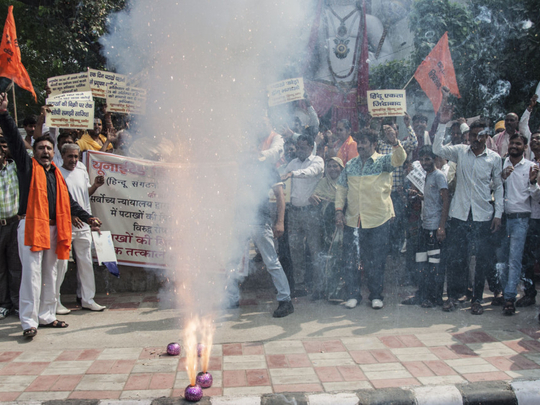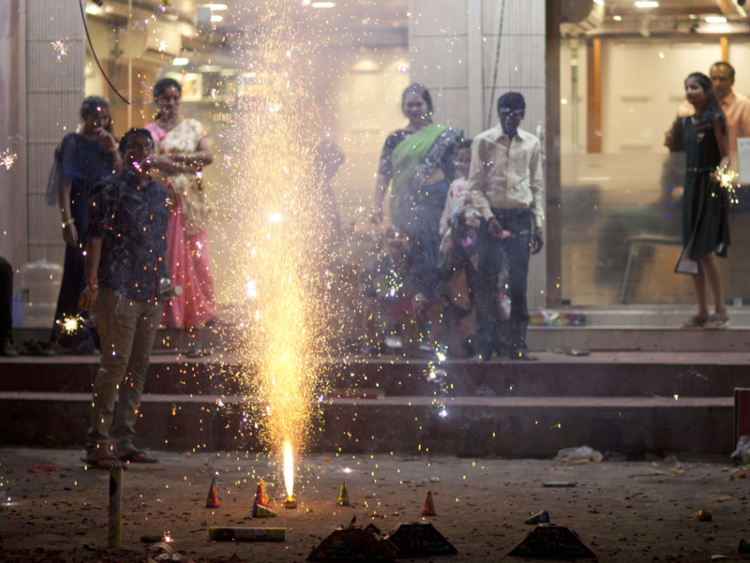
The Sangh Parivar (saffron brotherhood) is displeased with the Indian judiciary. Its latest grouse is about the Supreme Court’s ban on crackers.
First off the block to express discontent was the Tripura Governor, Tathagata Roy. Speaking as a Hindu, since it would have been constitutionally improper for him to use Raj Bhavan stationery to issue a statement, he wondered whether the courts will crack down on cremations next. Following the governor’s outburst, a Rashtriya Swayamsevak Sangh (RSS) functionary voiced the fear that diyas or the lamps lit during the Diwali festival might also be prohibited.
Following these expressions of disquiet by the higher-ups in the saffron camp, posters written in Hindi — the Parivar’s lingua franca — appeared in Delhi, criticising the judiciary. One of them said: “For Yakub Memon, the Supreme Court holds a hearing at 2 in the morning. When will it make time to hear a plea to allow small children to play with fireworks?” Another said: “There are crores of cases pending in court. But the judge (only) seems to find time for cases to do with festivals like dahi handi, jallikattu, Diwali”.
The posters were all neatly printed, pointing to an effective organisational network behind them not unlike the ‘Ganeshji doodh pi rahein hain’ (‘Lord Ganesha is drinking milk’) campaign in Delhi and elsewhere in 1995, or like the mysterious appearance of chapatis (hand-made wheat breads) on the doorsteps of various households on the eve of the 1857 uprising.
Those savvy on the internet also got into the act. One of them said that the Supreme Court is “setting a dangerous precedent and is also setting itself up for supreme disrespect for the law”. In addition to this call for defiance of the judiciary, the writer refers to the “anger in some quarters that the courts feel free to interfere only in Hindu religious customs and not those of the minorities”.
This, indeed, is the crux of the Hindutva (Hindu nationalist) angst. For all the formal commitment to the Constitution of India by the Bharatiya Janata Party (BJP) ministers, when taking their oaths of office, the saffron lobby has always felt that something is not quite right about the legal framework. As the RSS magazine, Organizer, said in 1949: “The worst about the new constitution of Bharat (India) is that there is nothing Bharatiya (Indian) about it. The drafters of the constitution have incorporated in it elements of British, American, Canadian, Swiss and sundry other constitutions. But there is no trace of ancient Bharatiya constitutional laws, institutions ... there is no mention of the unique constitutional development of ancient Bharat. Manu’s laws were written long before Lycurgus of Sparta or Solon of Persia. To this day, Manusmriti excites the admiration of the world ... But to our constitutional pundits that means nothing.”
However, the Parivar’s political twists do not hide the judiciary’s uneven endeavours to check air and noise pollution by banning fireworks. The efforts could not be delayed any longer, considering that India topped the list of the countries with the highest number of pollution-related deaths — 2.51 million — in 2015.
Notwithstanding the seriousness of the problem, the judiciary hasn’t followed a straight, unambiguous path. Instead, there have been unaccountable meanderings with bans being followed by their relaxation and vice versa. It is possible that there are reservations among the judges as well about a drastic intervention, which will reduce much of the gaiety associated with a traditional festival, even if the ill-effects of uncontrolled celebrations are becoming all too apparent.
There was need at this time for a meeting of minds between the legal and political entities to ensure that the health of the people is not jeopardised. After all, with the passage of time, restrictions have to be imposed on the customary observance of rituals as has been done in the case of the immersion of Durga idols in water bodies. But it will probably be too much to expect the country’s self-absorbed society and political class to understand the need for change and act in unison. Hence, the resistance to the ban on crackers by the saffron brotherhood. While its intention of consolidating the Hindu votes behind the BJP is obvious, what is also clear is that the saffronites are posing a challenge to the constitutional order.
It may be an insidious threat with little immediate prospect of the legal structure being undermined, let alone toppled, as the extreme Left — the Maoists — want. But the extreme Right’s objective is to breed disrespect towards the present system, thereby eroding its base.
To do so, it is banking on arousing the religious/cultural sentiments of the majority community to create an atmosphere of indifference, if not disdain, towards a major institution of the state.
What is more, their crafty tactics carry the danger of influencing the judiciary to make it act with greater circumspection on matters relating to religion in the future.
— IANS
Amulya Ganguli is a political analyst.











